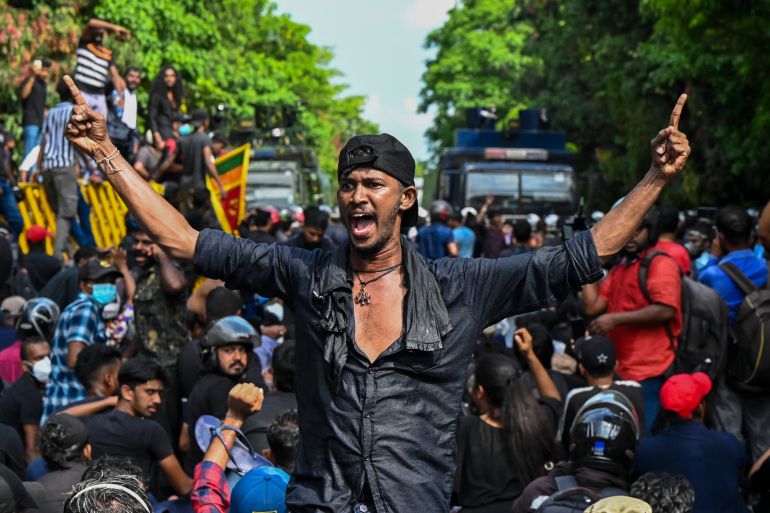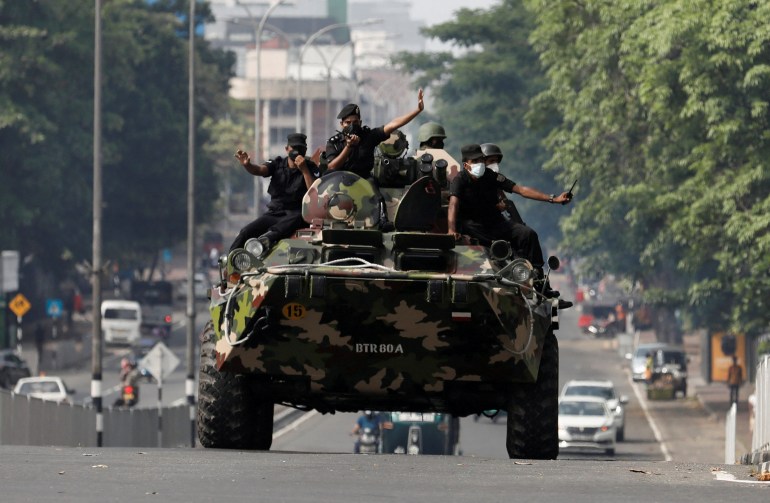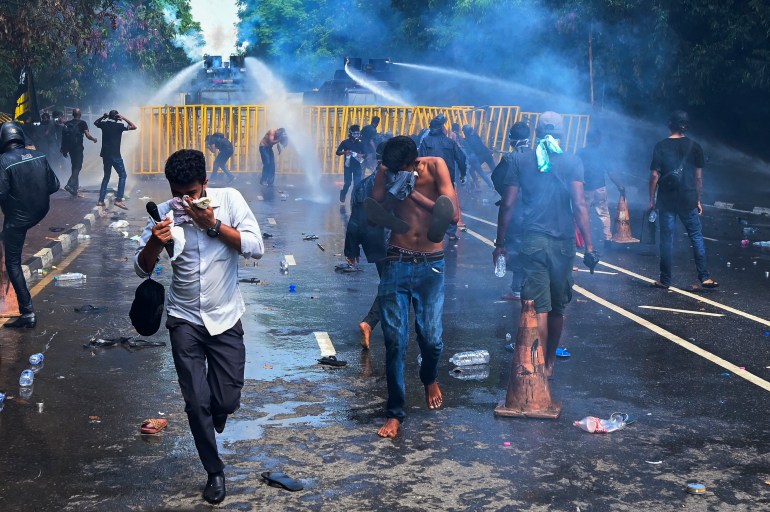How Sri Lanka spiralled into crisis and what happens next
The South Asian island nation is experiencing an unprecedented economic collapse that has pushed the government into a deep crisis.

Sri Lanka’s economic crisis has turned into deadly violence, which has killed eight people and wounded more than 200 so far.
The country’s powerful Prime Minister Mahinda Rajapaksa has resigned and his younger brother, President Gotabaya Rajapaksa, is seeking a way out of the chaos.
Keep reading
list of 4 itemsSri Lanka issues ‘shoot-on-sight’ order to quell unrest
Army evacuates former Sri Lankan PM from besieged residence
Photos: After PM, Sri Lanka protesters now want president to quit
Anti-government protesters, angry over power blackouts, shortages of basic goods and rising prices, are demanding that the president also steps down, but the retired military officer has invoked emergency powers in an attempt to maintain control.
The violence and political chaos gripping the island nation of 22 million comes 13 years after a brutal civil war ended in a bloody denouement in which tens of thousands of people were killed.

India, Sri Lanka’s northern neighbour, has extended billions of dollars in loans to help the country pay for vital supplies.
China, which has recently invested heavily in infrastructure projects in Sri Lanka – in what analysts say is an attempt to extend its influence across Asia – has intervened less publicly but said it supported efforts for the island nation to restructure its debt.
Sri Lanka’s vital negotiations with the International Monetary Fund (IMF) over a rescue plan, as well as plans to restructure its sovereign debt, could be thrown into disarray.
How did it come to this?
Much of the public ire has been directed at the Rajapaksa brothers, who are blamed by the protesters for leading the country into the economic crisis.
Analysts say economic mismanagement by successive governments weakened Sri Lanka’s public finances, leaving national expenditure in excess of its income and the production of tradable goods and services at inadequate levels.
The situation was exacerbated by deep tax cuts by the Rajapaksa government soon after it took office in 2019.
Months later, the COVID-19 pandemic struck, wiping out much of Sri Lanka’s revenue base, most notably from the lucrative tourism industry. Remittances from nationals working overseas dropped over the same period and were further sapped by an inflexible foreign exchange rate.
Rating agencies, concerned about government finances and its inability to repay large foreign debt, downgraded Sri Lanka’s credit ratings from 2020 onwards, eventually locking the country out of international financial markets.
To keep the economy afloat, the government leaned heavily on its foreign exchange reserves, eroding them by more than 70 percent in two years.
“Communication by the government was very poor, and people were not prepared for this dire situation we were in,” Ganeshan Wignaraja of the Overseas Development Institute told Al Jazeera.
Who are the Rajapaksa brothers?
The nationwide protests are demanding the removal of the Rajapaksa brothers – a dramatic change in fortune for Sri Lanka’s most powerful political dynasty.
Mahinda and Gotabaya Rajapaksa were cheered as heroes in 2009 by the island’s Buddhist-Sinhalese majority for ending a 30-year civil war against ethnic Tamil rebels.
Despite accusations of war atrocities, they amassed great popularity – Mahinda, who as president at the time oversaw the end of the war, and Gotabaya, a military strategist whose brutal campaign helped crush the rebels.
A powerful land-owning family from a rural southern district, the Rajapaksas dominated local elections for years before ascending to national politics in 2005 when Mahinda was elected president. He remained in power until 2015 when he was defeated by the opposition led by a former aide.
Following the 2019 Easter bombings, the family returned to power under Gotabaya, who ran for president on a nationalist campaign that won over voters disillusioned by the previous government over the attacks.
Critics have accused the Rajapaksas of relying heavily on the military to enforce policy, passing laws to weaken independent institutions and maintaining a near-monopoly on decision making. Three other Rajapaksa members were in the cabinet until early April when the full cabinet resigned over the protests.
Mahinda’s resignation on Monday is a partial victory for the demonstrators. With the protests continuing, especially outside the president’s office, there is renewed pressure on the president to quit too.
What did the government do?
Despite the rapidly deteriorating economic environment, the Rajapaksa government initially held off talks with the IMF.
For months, opposition leaders and financial experts urged the government to act but it held its ground, hoping for tourism to bounce back and remittances to recover.
Eventually, aware of the scale of the brewing crisis, the government did seek help from countries including India and China, regional superpowers who have traditionally jostled for influence over the strategically located island.
In all, New Delhi says it has provided support worth over $3.5bn this year.
Earlier in 2022, President Rajapaksa asked China to restructure repayments on around $3.5bn of debt owed to Beijing, which in late 2021 also provided Sri Lanka with a $1.5bn yuan-denominated swap.
Sri Lanka eventually opened talks with the IMF last month.
Despite outside support, fuel shortages have caused long queues at filling stations as well as frequent blackouts, and some crucial medicines have run low.
“To get the country back to some sense of normalcy, we need to urgently have a government in place, so that the law enforcement officers can control these mobs because otherwise, they could go berserk,” member of parliament Harsha De Silva told Al Jazeera.
Sri Lankan business groups are also leaning on the country’s politicians to find a solution quickly.
In a statement on Tuesday, the Joint Apparel Association Forum, which represents Sri Lanka’s vital apparel industry, said it was “critical” for a new government to take charge.

What happens next?
President Rajapaksa is without a prime minister and cabinet, which dissolved automatically after his brother resigned.
He can now select a member of parliament to become the next prime minister and form a cabinet. His choice will need the support of a majority of the 225-member legislature. It is unclear whether he still has enough backing in parliament for his candidate to be approved.
The president could attempt to form a unity government, but it will likely be difficult to convince opposition members to join.
If the president does resign while there is no prime minister, the speaker of parliament will become interim president for one month, during which parliament is to select a member to become president until an election can be held.
Also, a parliamentary motion to impeach Rajapaksa would not be easy. It would need the endorsement of the parliament’s speaker, the Supreme Court and the support of at least 150 lawmakers. Opposition parties do not hold a majority in parliament, making the process even harder.
In the 45 years that Sri Lanka has been ruled by an executive presidential system, there has been one failed attempt to remove a president. The constitution gives the president wide powers as commander-in-chief of the armed forces and head of the cabinet, as well as the power to appoint the chief justice, police chief and others.
The president, despite his extensive powers, still needs a prime minister and cabinet to carry out executive functions. The ongoing uncertainty over the president’s next moves and the administrative vacuum has raised fears of a military takeover, especially if violence escalates.